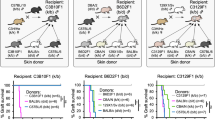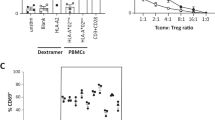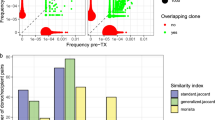Abstract
HLA-DP incompatibility is not considered as an exclusion criterion for bone marrow donors, because such incompatibility was not shown to affect significantly the risk for acute graft-versus-host disease (GVHD). In line with this clinical observation, it was proposed that in the context of bone marrow transplantation, HLA-DP determinants did not function as transplantation antigens in the same way as HLA-A, -B or -DR. In contrast to the above conclusion, we recently demonstrated the presence of HLA-DPB1*0501 specific T cell clones in a skin biopsy of a patient who developed aGVHD after receiving a bone marrow transplant (BMT) in which the only mismatched allele in the GVHD direction was HLA-DPB1*0501. At that time, this case was unique and occurred in a relatively uncommon graft setting where the patient received purified CD34+ BM cells from an unrelated donor. In the present study, we analyzed the immunological events associated with an aGVHD which occurred in the context of a ‘regular’ allogeneic BMT involving a single HLA-DPB1*1001 mismatch between donor and recipient in the GVHD direction. To this end, we analyzed several amplified T cell subsets present within a T cell line derived from a skin biopsy performed at the onset of GVHD. Our results demonstrated that T cell populations belonging to the TCRBV2, TCRB6.7, TCRBV14 and TCRBV17 subsets were specific for the HLA-DPB1*1001 mismatched allele. These data strengthen and generalize our first conclusion that a single HLA-DP mismatch between donor and recipient can activate a strong T cell response in vivo and consequently challenge the notion that HLA-DP incompatibility should not be taken into account in the choice of BM donors. Moreover, they also underline the idea that HLA-DP antigens may represent an interesting immune target for future therapeutic approaches.
This is a preview of subscription content, access via your institution
Access options
Subscribe to this journal
Receive 12 print issues and online access
$259.00 per year
only $21.58 per issue
Buy this article
- Purchase on Springer Link
- Instant access to full article PDF
Prices may be subject to local taxes which are calculated during checkout
Similar content being viewed by others
Author information
Authors and Affiliations
Rights and permissions
About this article
Cite this article
Gaschet, J., Gallot, G., Ibisch, C. et al. Acute graft-versus-host disease after bone marrow transplantation with a single HLA-DPB1*1001 mismatch: involvement of different TCRBV subsets. Bone Marrow Transplant 22, 385–392 (1998). https://doi.org/10.1038/sj.bmt.1701336
Received:
Accepted:
Published:
Issue Date:
DOI: https://doi.org/10.1038/sj.bmt.1701336
Keywords
This article is cited by
-
In a 12-allele analysis HLA-DPB1 matching is associated with improved OS in leukaemic and myelodysplastic patients receiving myeloablative T-cell-depleted PBSCT from unrelated donors
Bone Marrow Transplantation (2014)
-
Diverging effects of HLA–DPB1 matching status on outcome following unrelated donor transplantation depending on disease stage and the degree of matching for other HLA alleles
Leukemia (2010)
-
Greffes allogéniques à partir de donneurs non apparentés
Oncologie (2007)
-
The degree of matching at HLA-DPB1 predicts for acute graft-versus-host disease and disease relapse following haematopoietic stem cell transplantation
Bone Marrow Transplantation (2003)
-
DPB1 disparities contribute to severe GVHD and reduced patient survival after unrelated donor bone marrow transplantation
Bone Marrow Transplantation (2002)



